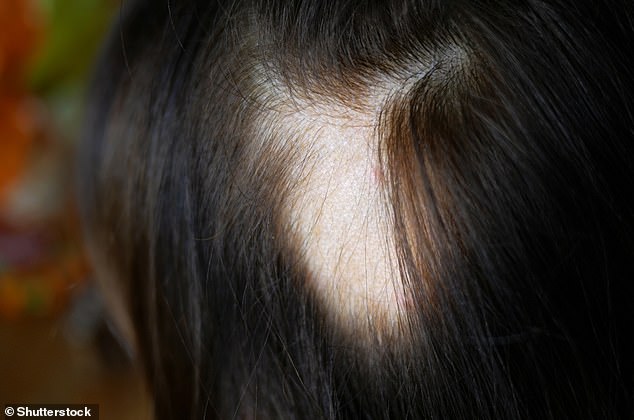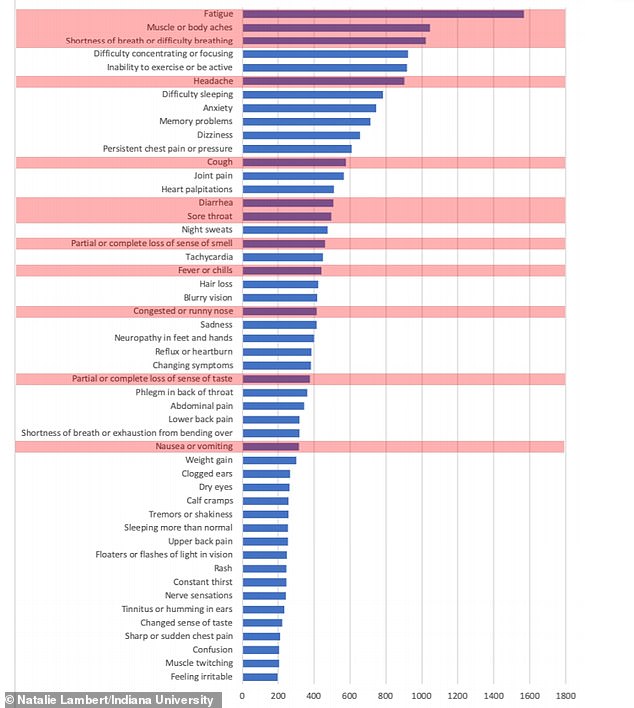Fatigue, loss of smell and chest pains are all some of the better known long-term effects that persist months after coronavirus infection.
But according to a new scientific paper, almost a quarter of Covid-19 survivors may have to adjust to hair loss too.
The study, published in The Lancet, reveals that 359 out of 1,655 patients hospitalised in Wuhan, China – 22 per cent – had experienced hair loss six months after being discharged.
Dermatologists say hair loss is a normal physiological response to a stressful event like an infectious illness and is only temporary – but Covid could be linked to conditions like alopecia, which can lead to irreversible hair loss.

Researchers at Chinese Academy of Medical Sciences found 22 per cent of people who recovered from Covid-19 experienced hair loss within the six months after leaving hospital
The Chinese authors wanted to investigate the long-term health consequences of Covid-19 – dubbed ‘long Covid’.
These symptoms, they say, ‘remain largely unclear’ – although the NHS lists 14 symptoms including fatigue, shortness of breath, insomnia, dizziness, joint pain and depression and anxiety.
‘Hair loss’ is absent from the NHS’s list, however.
‘The aim of this study was to describe the long-term health consequences of patients with Covid-19 who have been discharged from hospital,’ say the authors, from the Chinese Academy of Medical Sciences.

Alopecia areata develops when the body attacks its own hair follicles (where hair grows from), which can cause hair loss anywhere on the body (stock image)
TOP 10 LONG COVID SYMPTOMS
– Fatigue or muscle weakness: 63%
– Sleep difficulties: 26%
– Anxiety or depression: 23%
– Hair loss: 22%
– Smell disorder: 11%
– Palpitations: 9%
– Joint pain: 9%
– Decreased appetite: 8%
– Taste disorder: 7%
– Dizziness: 6%
Source: The Lancet/Chinese Academy of Medical Sciences
Advertisement
‘To our knowledge, this is the largest cohort study with the longest follow-up duration assessing the health consequences of adult patients discharged from hospital recovering from Covid-19.’
Covid-19 patients looked at for this study had been discharged from Jin Yin-tan Hospital in Wuhan between January 7 and May 29, 2020.
Six months later, patients were interviewed with a series of questionnaires for evaluation of symptoms and health-related quality of life, underwent physical examinations and a six-minute walking test, and received blood tests
Researchers found that the survivors were mainly troubled with fatigue or muscle weakness, sleep difficulties, and anxiety or depression – but hair loss was also one of the primary outcomes.
In all, 63 per cent had experienced fatigue or muscle weakness, 26 per cent had had sleeping difficulties and 23 per cent had had anxiety or depression, as well as 22 per cent with hair loss.
The findings follow an investigation into ‘long hauler’ Covid symptoms, published last summer by Dr Natalie Lambert from Indiana University School of Medicine.
Dr Lambert collected 1,567 responses in an online survey from people with long Covid symptoms.
She found 423 of this total had experienced hair loss – the 21st most commonly cited symptom on a list of the 50 (which was topped by fatigue).
Long haulers’ Covid-19 symptoms are ‘far more numerous’ than the 11 currently listed on the website of the Centers for Disease Control and Prevention, she pointed out.
‘While the impact of Covid-19 on the lungs and vascular system have received some media and medical attention, the results of this survey suggest that brain, whole body, eye, and skin symptoms are also frequent-occurring health problems for people recovering,’ Dr Lambert said.

Results from the survey by Dr Natalie Lambert from Indiana University School of Medicine. Numbers on the x-axis refer to how many survey respondents said they had the symptoms along y-axis. The red-shaded symptoms are those listed by Centers for Disease Control and Prevention
What is telogen effluvium?
Telogen effluvium is a condition in which a person sheds more hair than normal, and it can be triggered by childbirth.
It is normal for someone to be in the process of shedding about 10 per cent of the hair on their head at one time, because it grows continuously to make sure the total number of hairs remains constant.
Telogen effluvium occurs when that number rises to 30 or more per cent, and the person is losing noticeable amounts of hair.
The condition occurs because of a disturbance to the normal hair growing cycle. It can be triggered by childbirth, trauma or illness, stress, extreme weight loss, medications, or a skin condition affecting the scalp.
Telogen effluvium usually clears itself up within three to six months, but it may take longer for hair to regrow to its normal length.
Source: British Association of Dermatologists
Advertisement
According to the American Academy of Dermatology (AAD), Covid-induced hair loss is due to telogen effluvium (TE) – a shedding condition caused by a disturbance in the hair growth cycle.
TE results in a high percentage of anagen follicles (follicles which are actively growing hair), going into their resting phase prematurely across the scalp
TE lasts somewhere between six to nine months before hair returns to its normal thickness and appearance, it says.
‘It happens when more hairs than normal enter the shedding (telogen) phase of the hair growth lifecycle at the same time,’ AAD says.
‘A fever or illness can force more hairs into the shedding phase. Most people see noticeable hair shedding two to three months after having a fever or illness.’
Specialists at the Belgravia Centre in London have also reported an uplift in cases of telogen effluvium since the start of the pandemic.
Nearly two thirds (64 per cent) of male patients and over a third of women (38 per cent) diagnosed with TE at the Belgravia Centre reported having experienced Covid-19 related symptoms, they found last year.
‘It’s quite common for TE-related hair loss to present around three months after a period of severe trauma, illness or stress, which fits with our findings,’ said Rali Bozhinova, superintdent trichologist at the Belgravia Centre.
‘The spike in diagnoses shows the extent of stress that the virus places on the body, not only causing temporary TE, but also potentially exacerbating other hair loss conditions which can have long lasting effects if left untreated.’
Another expert suggested Covid-19 could be linked to alopecia areata, which leads to coin-sized bald patches on the scalp.
Alopecia areata can result in total hair loss, called alopecia universalis, and it can prevent hair from growing back.
In these cases, Covid-19 may trigger an auto-immune response, where the body attacks its own hair follicles, switching them off, according to trichologist Iain Sallis, who wasn’t involved in the Chinese study.
‘Covid, as many other febrile illnesses, have the ability to confuse our auto-immune system,’ Sallis told MailOnline.
‘Any type of shock be it, physical, emotional or psychological can cause alopecia, so it can most certainly be classed as a possible trigger.’
There is currently a joint effort by dermatologists called SECURE-DERM to look at the effects of Covid on hair loss on a global scale.
Is Boris Johnson going bald? PM’s trademark mop shows signs of thinning after his coronavirus battle 

Boris Johnson’s trademark messy mop may be a way for him to hide bald patches, Twitter users have speculated. Pictured left in Downing Street last week and right in January
Eagle-eyed social media users have spotted the Prime Minister’s trademark shaggy, blond mop has looked thinner than usual over the past few weeks.
And his hair loss was more apparent than ever last week, when he stood in front of the nation in a Downing Street press conference to announce he was was ‘squeezing the brake pedal’ on easing lockdown because of a rise in cases.
But the PM has reportedly showed signs of going bald since 2016, meaning it’s not clear if it has worsened since his battle with coronavirus in April, which he described as a ‘tough old moment’ which left him in intensive care for several nights.
It comes amid dozens of anecdotal reports of Covid-19 survivors losing their hair after recovering from the life-threatening illness.
Many social media users have commented on Mr Johnson’s hair over the past month.
One Twitter user wrote: ‘Boris Johnson is very bald now and has been taking hair styling lessons from the baldest man in the White House for many decades, Donald Trump.’
Another said: ‘Is Boris Johnson going bald? Nothing wrong in being bald, just the increasingly Trumpian hairstyle is not good.’
And one wrote: ‘It is becoming increasingly challenging to detect and discernible difference between Donald Trump and Boris Johnson (apart from the size of Boris’s bald patch).’
While another simply said: ‘The ”untidy” hair is carefully positioned to hide the bald cranium.’
The Mail on Sunday’s Black Dog column revealed: ‘Boris Johnson’s diplomatic ditching of his dishevelled hairdo to mark his debut Commons speech as Foreign Secretary in the Aleppo debate has one downside: Dog’s lofty vantage point in the Press Gallery revealed a looming bald patch on Bozza’s bonce.
‘No wonder he is always ruffling his tresses: it’s his version of the Donald Trump Comb-Over…’.



Social media users have been quick to point out that Mr Johnson’s trademark ruffled ‘do bears a striking resemblance to Donald Trump’s combover
Advertisement
Source link : https://www.dailymail.co.uk/sciencetech/article-9287057/Coronavirus-linked-hair-loss-22-patients-study-warns.html











